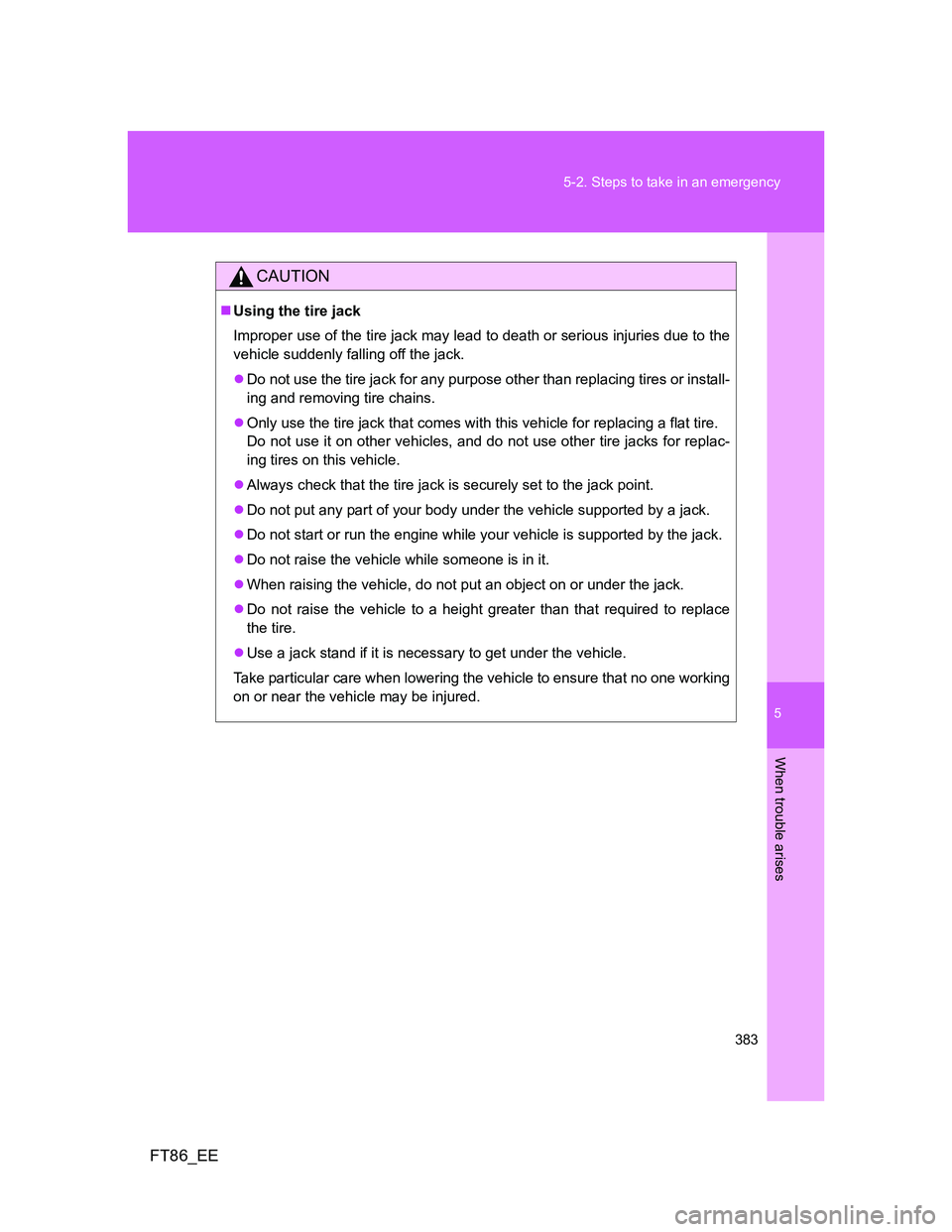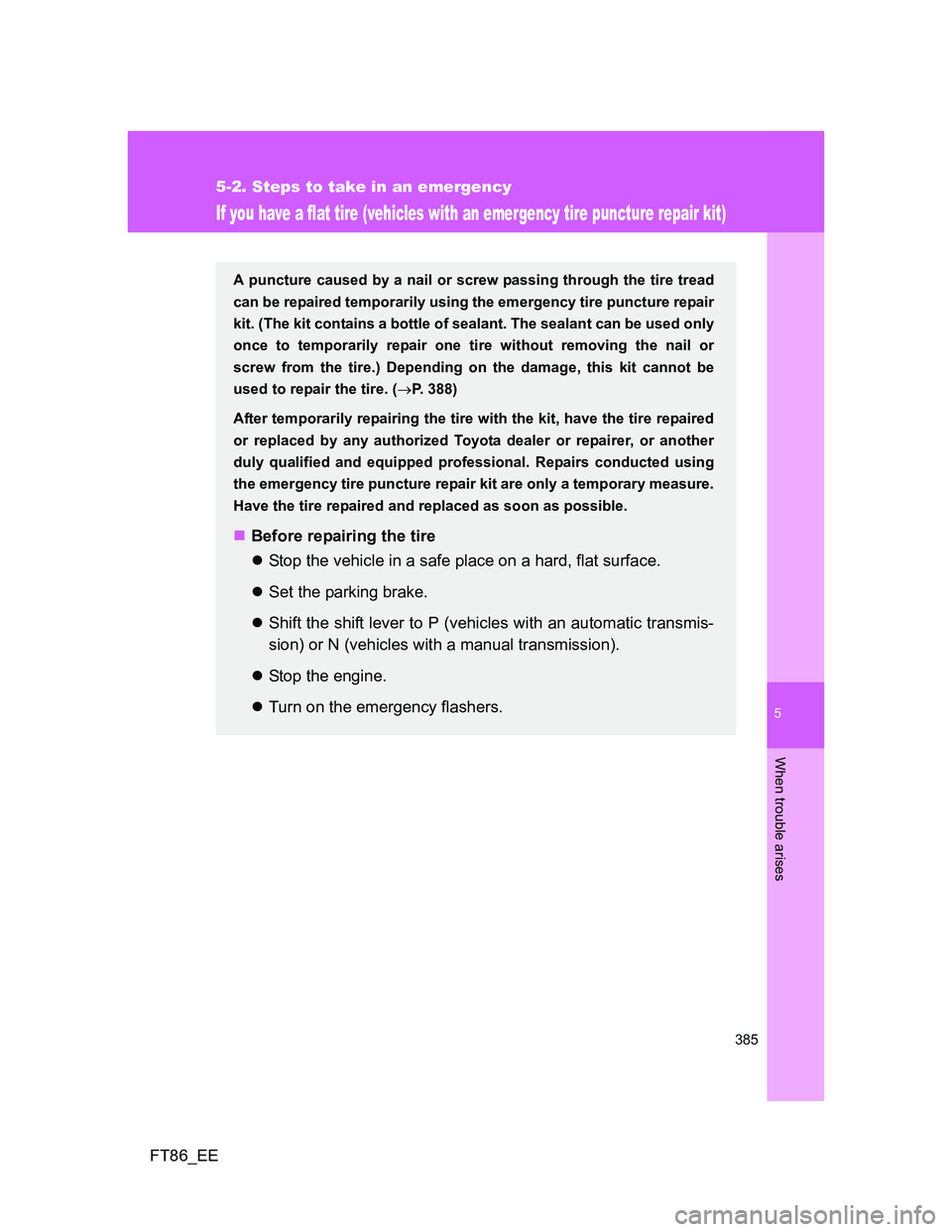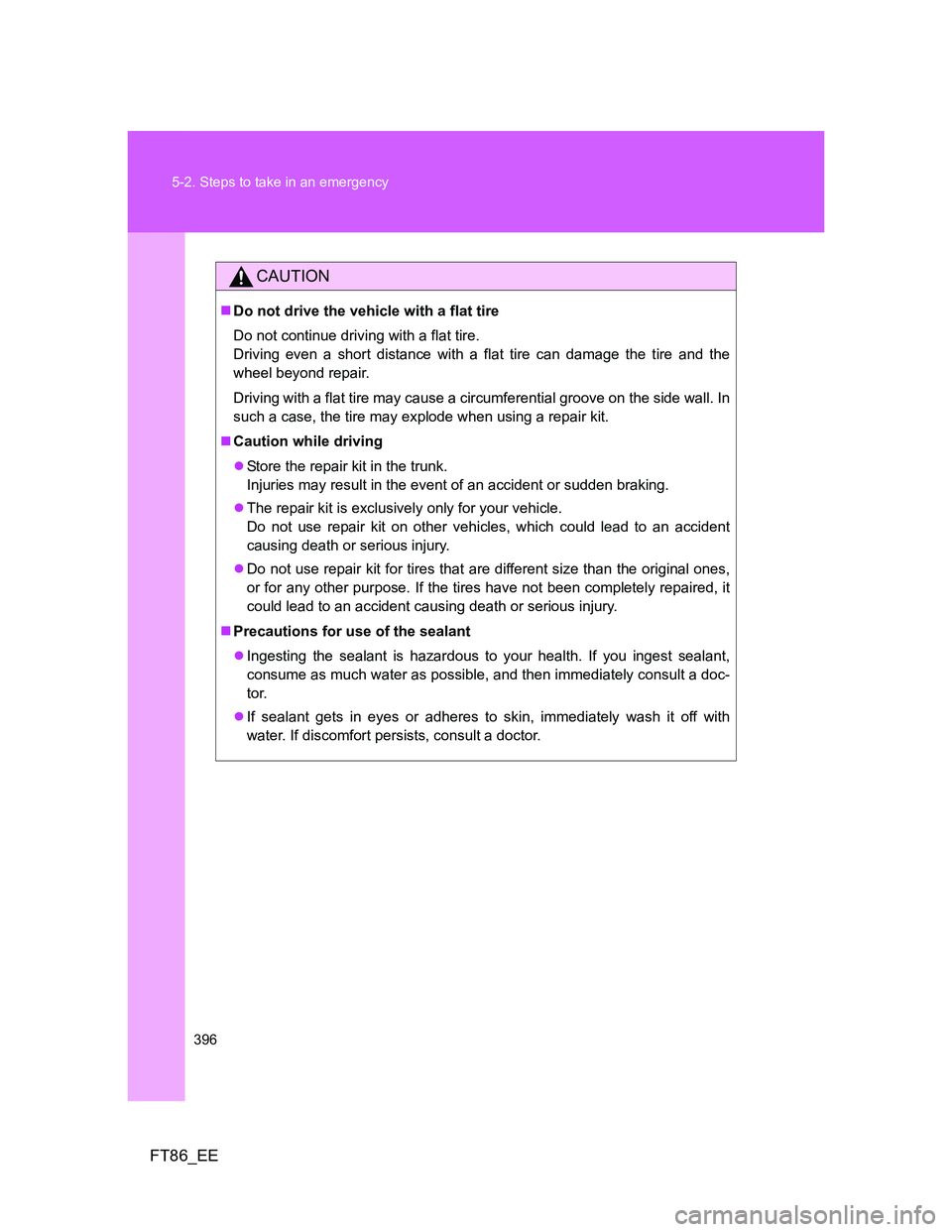Page 381 of 452
5
381 5-2. Steps to take in an emergency
When trouble arises
FT86_EEFirmly tighten each nut two or
three times in the order shown in
the illustration.
Tightening torque:
120 N•m (12.2 kgf•m, 89 ft•lbf)
Stow the flat tire, tire jack and all tools.
STEP 4
Storing the tire
STEP 5
Always install the center fastener as
shown in the illustration.
Page 383 of 452

5
383 5-2. Steps to take in an emergency
When trouble arises
FT86_EE
CAUTION
Using the tire jack
Improper use of the tire jack may lead to death or serious injuries due to the
vehicle suddenly falling off the jack.
Do not use the tire jack for any purpose other than replacing tires or install-
ing and removing tire chains.
Only use the tire jack that comes with this vehicle for replacing a flat tire.
Do not use it on other vehicles, and do not use other tire jacks for replac-
ing tires on this vehicle.
Always check that the tire jack is securely set to the jack point.
Do not put any part of your body under the vehicle supported by a jack.
Do not start or run the engine while your vehicle is supported by the jack.
Do not raise the vehicle while someone is in it.
When raising the vehicle, do not put an object on or under the jack.
Do not raise the vehicle to a height greater than that required to replace
the tire.
Use a jack stand if it is necessary to get under the vehicle.
Take particular care when lowering the vehicle to ensure that no one working
on or near the vehicle may be injured.
Page 384 of 452

384 5-2. Steps to take in an emergency
FT86_EE
CAUTION
Replacing a flat tire
Do not touch the disc wheels or the area around the brakes immediately
after the vehicle has been driven.
After the vehicle has been driven the disc wheels and the area around the
brakes will be extremely hot. Touching these areas with hands, feet or
other body parts while changing a tire, etc. may result in burns.
Do not attach a heavily damaged wheel ornament, as it may fly off the
wheel while the vehicle is moving.
Failure to follow these precautions could cause the wheel nuts to loosen
and the tire to fall off, resulting in death or serious injury.
• Have the wheel nuts tightened with a torque wrench to 120 N
•m (12.2
kgf
•m, 89 ft•lbf) as soon as possible after changing wheels.
• When installing a tire, only use wheel nuts that have been specifically
designed for that wheel.
• If there are any cracks or deformations in the bolt screws, nut threads
or bolt holes of the wheel, have the vehicle inspected by any autho-
rized Toyota dealer or repairer, or another duly qualified and equipped
professional.
• When installing the wheel nuts, be sure to install them with the tapered
ends facing inward. (P. 323)
NOTICE
Do not drive the vehicle with a flat tire.
Do not continue driving with a flat tire.
Driving even a short distance with a flat tire can damage the tire and the
wheel beyond repair.
Stowing the jack
When stowing the jack in the jack holder, make sure that the part that the
jack handle attaches to is pointing towards the inside of the trunk. Failure to
do so may damage the vehicle body.
Page 385 of 452

5
385
5-2. Steps to take in an emergency
When trouble arises
FT86_EE
If you have a flat tire (vehicles with an emergency tire puncture repair kit)
A puncture caused by a nail or screw passing through the tire tread
can be repaired temporarily using the emergency tire puncture repair
kit. (The kit contains a bottle of sealant. The sealant can be used only
once to temporarily repair one tire without removing the nail or
screw from the tire.) Depending on the damage, this kit cannot be
used to repair the tire. (P. 388)
After temporarily repairing the tire with the kit, have the tire repaired
or replaced by any authorized Toyota dealer or repairer, or another
duly qualified and equipped professional. Repairs conducted using
the emergency tire puncture repair kit are only a temporary measure.
Have the tire repaired and replaced as soon as possible.
Before repairing the tire
Stop the vehicle in a safe place on a hard, flat surface.
Set the parking brake.
Shift the shift lever to P (vehicles with an automatic transmis-
sion) or N (vehicles with a manual transmission).
Stop the engine.
Turn on the emergency flashers.
Page 393 of 452
5
393 5-2. Steps to take in an emergency
When trouble arises
FT86_EETurn the compressor switch “ON”
and fill the tire with air until the
specified inflation pressure is
reached.
Turn the switch “OFF” when the pressure gauge connected to
the hose reads the specified pressure.
If the inflation pressure is not attained within 10 minutes, emergency
repair is not possible due to severe damage. Contact any authorized
Toyota dealer or repairer, or another duly qualified and equipped pro-
fessional.
After completely filling the tire with air, disconnect the hose
from the valve on the tire and pull the power plug of the com-
pressor out of the power outlet on the vehicle.
To spread the liquid sealant evenly in the tire, immediately
drive for about 10 minutes.
After driving about 10 minutes,
pull your vehicle over in a safe
place and reconnect the com-
pressor.
STEP15
Switch
STEP16
STEP17
STEP18
STEP19
Page 394 of 452
394 5-2. Steps to take in an emergency
FT86_EERead the inflation pressure on
the pressure gauge.
If the pressure is 130 kPa (1.3
kgf/cm
2 or bar, 19 psi) or above,
fill the tire with air using the com-
pressor until the specified infla-
tion pressure is reached.
If the pressure is less than 130
kPa (1.3 kgf/cm
2 or bar, 19 psi),
the emergency repair that have
been performed is not safe for
use as damage to the tire is too
severe. Do not continue to drive
the vehicle. Contact any autho-
rized Toyota dealer or repairer, or
another duly qualified and
equipped professional.
Taking precautions to avoid sudden braking, sudden accelera-
tion and sharp turns, drive carefully at under 80 km/h (50
mph) to the nearest authorized Toyota dealer or repairer, or
another duly qualified and equipped professional for tire repair
or replacement.
STEP20
STEP21
Page 396 of 452

396 5-2. Steps to take in an emergency
FT86_EE
CAUTION
Do not drive the vehicle with a flat tire
Do not continue driving with a flat tire.
Driving even a short distance with a flat tire can damage the tire and the
wheel beyond repair.
Driving with a flat tire may cause a circumferential groove on the side wall. In
such a case, the tire may explode when using a repair kit.
Caution while driving
Store the repair kit in the trunk.
Injuries may result in the event of an accident or sudden braking.
The repair kit is exclusively only for your vehicle.
Do not use repair kit on other vehicles, which could lead to an accident
causing death or serious injury.
Do not use repair kit for tires that are different size than the original ones,
or for any other purpose. If the tires have not been completely repaired, it
could lead to an accident causing death or serious injury.
Precautions for use of the sealant
Ingesting the sealant is hazardous to your health. If you ingest sealant,
consume as much water as possible, and then immediately consult a doc-
tor.
If sealant gets in eyes or adheres to skin, immediately wash it off with
water. If discomfort persists, consult a doctor.
Page 397 of 452
5
397 5-2. Steps to take in an emergency
When trouble arises
FT86_EE
CAUTION
When fixing the flat tire
Stop your vehicle in a safe and flat area.
If force is used to turn the valve core tool while air remains in the tire, spe-
cial care should be taken because the valve core could fly out.
Be careful, as sealant may fly out if you shake the bottle with the hose
installed.
Do not touch the wheels or the area around the brakes immediately after
the vehicle has been driven.
After the vehicle has been driven, the wheels and the area around the
brakes may be extremely hot. Touching these areas with hands, feet or
other body parts may result in burns.
Connect the valve and hose securely with the tire installed on the vehicle.
If the hose is not properly connected to the valve, air leakage may occur
as sealant may be sprayed out.
If the hose comes off the valve while inflating the tire, there is a risk that
the hose will move abruptly due to air pressure.